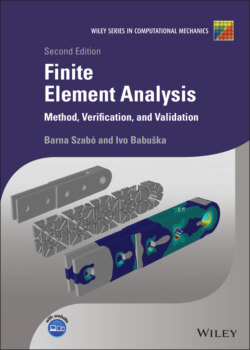Читать книгу Finite Element Analysis - Barna Szabó - Страница 11
ОглавлениеPreface to the first edition
There are many books on the finite element method today. It seems appropriate therefore to say a few words about why this book was written. A brief look at the approximately 30‐year history of the finite element method will not only help explain the reasons but will also serve to put the main points in perspective.
Systematic development of the finite element method for use as an analytical tool in engineering decision‐making processes is usually traced to a paper published in 1956.1 Demand for efficient and reliable numerical methods has been the key motivating factor for the development of the finite element method. The demand was greatly amplified by the needs of the space program in the United States during the 1960s. A great deal was invested into the development of finite element analysis technology in that period.
Early development of the finite element method was performed entirely by engineers. The names of Argyris, Clough, Fraeijs de Veubeke, Gallagher, Irons, Martin, Melosh, Pian, and Zienkiewicz come to mind in this connection.2
Development of the finite element method through the 1960s was based on intuitive reasoning, analogies with naturally discrete systems, such as structural frames, and numerical experimentation. The errors of discretization were controlled by uniform or nearly uniform refinement of the finite element mesh. Mathematical analysis of the finite element method begun in the late 1960s. Error estimation techniques were investigated during the 1970s. Adaptive mesh refinement procedures designed to reduce the errors of discretization with improved efficiency received a great deal of attention in this period.3
Numerical experiments conducted in the mid‐1970s indicated that the use of polynomials of progressively increasing degree on a fixed finite element mesh can be much more advantageous than uniform or nearly uniform mesh refinement.4 To distinguish between reducing errors of discretization by mesh refinement and the alternative approach, based on increasing the degree of the polynomial basis functions, the labels h‐version and p‐version gained currency for the following reason: Usually the symbol h is used to represent the size of the finite elements. Convergence occurs when the size of the largest element (hmax) is progressively reduced. Hence the name: h‐version. The polynomial degree of elements is usually denoted by the symbol p. Convergence occurs when the lowest polynomial degree pmin is progressively increased. Hence the name: p‐version. The h‐ and p‐versions are just special applications of the finite element method which, at least in principle, allows changing the finite element mesh concurrently with increasing the polynomial degree of elements. This general approach is usually called the hp‐version of the finite element method. The theoretical basis for the p‐version was established by 1981.5 The understanding of how to combine mesh refinement with p‐extensions most effectively was achieved by the mid‐1980s.6
The p‐version was developed primarily for applications in solid mechanics. A closely related recent development for applications primarily in fluid mechanics is the spectral element method.7
The 1980s brought another important development: superconvergent methods for the extraction of engineering data from finite element solutions were developed and demonstrated. At the time of writing good understanding exists regarding how finite element discretizations should be designed and how engineering data should be extracted from finite element solutions for optimal reliability and efficiency.
The knowledge which allows construction of advanced finite element computer programs, that work efficiently and reliably for very large classes of problems, and all admissible data that characterize those problems, is well established today. It must be borne in mind, however, that finite element solutions and engineering data extracted from them can be valuable only if they serve the purposes of making correct engineering decisions.
Our purpose in writing this book is to introduce the finite element method to engineers and engineering students in the context of the engineering decision‐making process. Basic engineering and mathematical concepts are the starting points. Key theoretical results are summarized and illustrated by examples. The focus is on the developments in finite element analysis technology during the 1980s and their impact on reliability, quality assurance procedures in finite element computations, and performance. The principles that guide the construction of mathematical models are described and illustrated by examples.
Notes
1 1 Turner MJ, Clough RW, Martin HC and Topp LJ, Stiffness and deflection analysis of complex structures. Journal of Aeronautical Sciences 23(9), 805–824, 1956.
2 2 Williamson CF, Jr. A History of the Finite Element Method to the Middle 1960s. Doctoral Dissertation, Boston University, 1976.
3 3 Babuška I and Rheinboldt WC. Adaptive approaches and reliability estimations in finite element analysis. Computer Methods in Applied Mechanics and Engineering, 17/18, 519–540, 1979.
4 4 Szabó BA and Mehta AK. p‐convergent finite element approximations in fracture mechanics. Int. J. Num. Meth. Engng., 12. 551–560, 1978.
5 5 Babuška I, Szabó B and Katz IN. The p‐version of the finite element method. SIAM J. Numer. Anal., 18, 515–545, 1981.
6 6 Babuška I. The p‐ and hp‐versions of the finite element method. The state of the art. In: DL Dwoyer, MY Hussaini and RG Voigt, editors, Finite Elements: Theory and Applications, Springer‐Verlag New York, Inc., 1988.
7 7 Maday Y and Patera AT. Spectral element methods for the incompressible Navier‐Stokes equations. In: AK Noor and JT Oden, editors. State‐of‐the‐Art Surveys on Computational Mechanics, American Society of Mechanical Engineers, New York, 1989.
